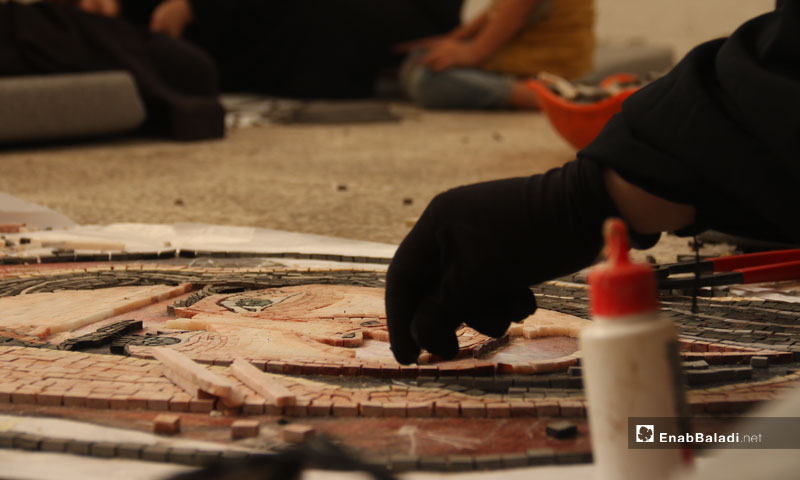



Um Rifaat aims to better her living conditions, driven by her passion for the art of “Mosaic,” which her city of Kafr Nabl has been famous for decades ago, rather civilizations ago, starting with the Roman civilization and ceasing not with the war circumstances today witnessed by the city.
The Syrian women, the daughter of the city of Kafr Nabl, rural Idlib, receives a vocational training on the “Mosaic” craft, along with other 30 women, most of whom are widows or wives of detainees, who joined the “Ghazal” Center since its launch on August 20, for the first course that is about to end.
The Director of the Center Ahmad Adnan al-Dani told Enab Baladi that the objective of starting a center, specialized in teaching the art of “Mosaic,” is to preserve it, through spreading its culture among the new generations and women, as well, for this craft has, to a certain degree, always been restricted to men in the Syrian society.
He added that the center has directed its first course to the class of vulnerable women in the city of Kafr Nabl, widows and detainees’ wives in particular, who have the responsibility of finding for their children and families, as al-Dani put it.
According to the Center’s schedule, the duration of each of the courses is three months, targeting 30 women, with tow shifts, one at the morning and another in the evening, to end with an exhibition where the artistic pieces done by the women trainees, during the training process, are presented.
Um Rifaat told Enab Baladi that when she joined the “Ghazal” Center, she knew nothing about the “Mosaic” industry, and now she is more into the craft.
“Among us, there are women who excelled this art. We are waiting for the launch of an exhibition for our own pieces,” she said.
It is decided that the women trainees work in the filed of “Mosaic” making, within small home-based projects, capable of providing them with a monthly income, according to the Director of the “Ghazal” Center Ahmad al-Dani, who pointed out that this craft does not require costly tools, and it only demands buying the stones, which are already available at Kafr Nabl, in addition to the manual stone cutting tool.
Al-Dani comes from a family that has been famous for its mastery of the “Mosaic” industry in the city of Kafr Nabl since the nineties of the last century, promoted by the artist Mohammad al-Dani, who used to teach art.
Mosaic is an ancient Syrian art that is more than 300 years deep in Damascus’ history; it is the art of grafting wood with shells, silver or ivory. Early in the 19th century, mosaic existed in the houses of almost all well-established Syrian families, after which it became a familiar décor in presidential palaces around the world.
The art of “Mosaic” is equally famous in Idlib governorate, in the city of Kafr Nabl in particular, considered one of the key sources of its production and marketing within Arab states.
The craft utilizes different types of wood including walnut, beech and other types, but the delicacy of it lies in the maker’s imagination, who innovatively manipulate geometrical shapes, octagons, squares, hexagons and triangles, to come up with unique pieces.
During the Syrian war, interest in this craft has gradually declined; however, the mosaic factories and workshops in the capital city are still functioning, and some of the challenges which face this industry include expensive raw materials, the absence of local mosaic exhibitions and the difficulty of participating in Arab and international exhibitions.
The major challenge, nonetheless, is that the market today presents similar products, cheap and of commercial qualities, in terms of the used wood and raw materials, in addition to the fact that they are machine not handmade.
if you think the article contain wrong information or you have additional details Send Correction